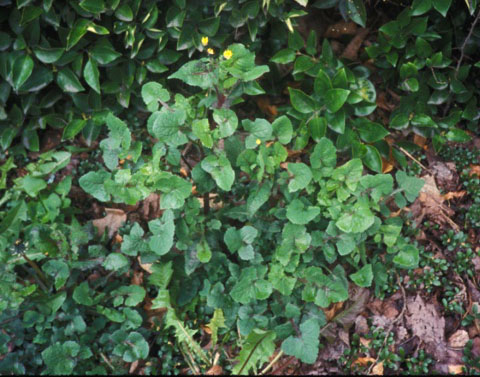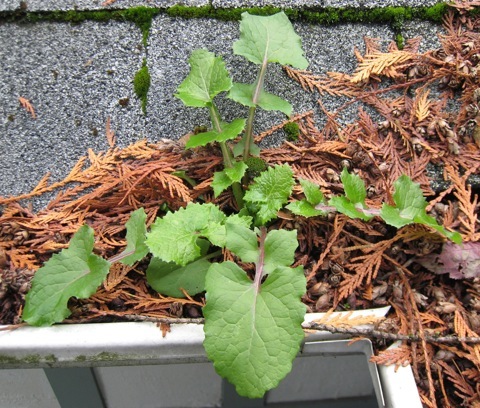
|

|
| Sow Thistle; Sonchus oleraceus L. |
Sunflower Family; COMPOSITÆ (ASTERACEÆ)
|
| From the very first time we hear the name Sow Thistle, we are prejudiced against this weed; opprobrium infects every
syllable. Science's name is more inviting though initially just as incomprehensible without explanation:
oleraceus is a Latin reference to the plant being good eating, not mere swine's fare. In fact, Sow Thistles are close cousins of lettuces, and the best specimens are
described more truly as wild salad herbs than as loathsome weeds. Taste the greens and maybe you'll agree. We have all been assured
that dandelions are delicious, nutritious and not to be ignored. Well, Sow Thistle is neither bitter as dandelion nor such a demon in
the garden, so people can eat it more and curse it less. |
| Three species of Sonchus, originally from the Old World, grow around here. By far most abundant is the one aptly
called Common Sow Thistle, Sonchus oleraceus. It is a familiar sight, being one of several coarse dandelion relatives producing
yellow flowers, puffy seed-heads, and oozing white sap from broken stems. Like dandelion, Sow Thistle grows in a wide variety of
habitats, so can be found practically anywhere. Flowers are mostly seen May through December. It is an annual, whose erect, stout,
hollow, branching stem usually grows to three feet, but can reach seven and a half feet, bearing over the months hundreds of flowers,
thousands of seeds. The seed-balls of whitish plumes are not as large, pure and lovely as those of dandelion. |
| Don't let Sow Thistles reseed in your garden, for they can overrun the place. Even if you weed diligently, some may escape
your notice until they are large enough to afford leaves worth eating. Early spring is best for harvest, as the growth is rank and still
mild. Mix a few tender young Sow Thistle leaves in your salads; their bitterness will be drowned by sweeter ingredients. Eating some
bitter greens is healthy, for though the flavor is unpleasant, the nutritive and stimulative properties are keen. Blanching and cooking
reduce bitterness, for those who find it especially offensive. The strong point in favor of learning to accept Sow Thistle leaves raw, is that
you can then nibble them whenever you happen to chance upon a good-looking specimen. |
Bitterness is relative, and for anyone unaccustomed to it, Sow Thistle is revoltingly horrible. In defense,
really foul flavor resides in wild chicory and teasel leaves. Compared to them, almost painful in their repulsiveness, Sow Thistle is merely a
strong-flavored lettuce. Moreover, a breeding program could probably easily reduce the bitterness, even as endive was coaxed from wild chicory,
and tame lettuce originally was a yucchy wild weed.
|
Originally published as the Seattle Tilth newsletter Weed of the Month in May 1992, along with an illustration from a book.
Back |
|
|

